Double Elimination Debate: Structure, Strategy, and Success
Updated On: October 26, 2025 by Aaron Connolly
What Is Double Elimination?
Double elimination is a tournament format where you have to lose twice before you’re out of the competition.
This setup gives everyone a fairer shot since you get a second chance through a losers’ bracket if you stumble early.
Definition and Fundamental Principles
A double-elimination tournament uses two brackets running side by side: the winners’ bracket and the losers’ bracket.
Everyone begins in the winners’ bracket.
If your team loses a match, you drop into the losers’ bracket, but you’re still in the running unless you lose again.
Key principles:
- You need two losses to be eliminated
- Winners stay in the upper bracket
- First-time losers get another shot
- Only one team can finish undefeated
The final round usually makes the losers’ bracket winner beat the winners’ bracket champ twice to take the title.
If the losers’ bracket team wins the first final, both teams have one loss, so they face off again.
Double-Elimination Versus Single-Elimination
Single-elimination tournaments kick you out after one loss. It’s quick, but there’s no coming back.
Single-elimination basics:
- One loss and you’re done
- Tournaments finish faster
- Fewer matches overall
- Every match feels do-or-die
Double elimination gives strong teams more chances if they slip up early. For example, a top seed can lose in the first round but still make a comeback and win it all.
You’ll see a lot more matches in double elimination. With eight teams, single elimination only needs seven matches, but double elimination takes 14 or 15, depending on whether there’s a bracket reset.
Key differences:
- Double elimination takes more time
- More matches mean higher costs for venues
- Players get more time in the spotlight
- Strong teams can recover from a bad start
Origins and Evolution of the Format
Double elimination first popped up in American baseball in the early 1900s.
People liked it because one bad day didn’t ruin your whole season.
Wrestling picked it up too, mostly to make sure rankings felt fair. Even if you lost early, you could still fight back for a medal.
Today, you’ll see double elimination in:
- NCAA baseball and softball
- Esports events like Dota 2’s The International
- Amateur wrestling
- Pool and billiards
Esports really took this format and ran with it. Some tournaments now tweak the rules so finals are just one match, no matter where you came from.
Plenty of gaming tournaments mix group stages with double elimination. Teams play round-robins, then move into brackets based on how they did.
Time pressure has changed things, especially in esports. Winners’ bracket teams usually get more rest, while losers’ bracket teams sometimes have to grind through several matches in a day.
Double Elimination Debate Structure
Double elimination debate tournaments connect two brackets, letting debaters recover after their first loss.
Teams move through the winners’ bracket when they win, or drop into the losers’ bracket if they lose, which opens up more ways to reach the championship.
The Winners’ Bracket Path
The winners’ bracket is where all undefeated teams compete.
If you win your first debate, you move forward in the winners’ bracket and face other undefeated teams.
Each round works like a classic elimination—win and you advance, lose and you drop down.
Why stay in the winners’ bracket?
- You debate fewer times overall
- You only face teams that haven’t lost yet
- The path to the championship is more direct
- You usually get more time to prepare between rounds
Teams that make it to the winners’ bracket final just need one more win to take the tournament. That’s a huge incentive to avoid early losses.
The Losers’ Bracket Route
The losers’ bracket picks up teams after their first defeat.
You can land here either from losing in the winners’ bracket or dropping your first debate.
The bracket gets pretty tangled at this point. Every match is an elimination—one more loss, and you’re out.
Losers’ bracket steps:
- Several rounds with teams joining from different places
- Teams from various winners’ bracket rounds meet up
- Each round knocks out about half the teams left
- The survivors keep fighting toward the losers’ bracket final
The losers’ bracket champ has to beat the winners’ bracket champ twice in the grand final, since they’ve already lost once.
Elimination Bracket Dynamics
Double-elimination brackets bring a bunch of strategic angles you don’t really see in single elimination.
Teams have to juggle risk and consistency, knowing there are multiple possible routes to the end.
Early rounds aren’t as cutthroat, since you’re not out after one loss. That can encourage teams to get creative or take risks.
Top teams can bounce back even if they get upset early. The losers’ bracket gives them a shot at redemption.
Strategic takeaways:
- You have to manage your energy and resources for more rounds
- You’ll prep for a wider variety of opponents
- Staying mentally tough after a loss is key
- Switching between brackets means adapting fast
The grand final really gives the winners’ bracket champ an edge. They just need one win, while the losers’ bracket team has to do it twice in a row.
Seeding and Initial Matchups
Seeding decides who faces whom in the first round, and honestly, it can shape the whole tournament.
Random draws can level the playing field or just make things wild, depending on how you see it.
Seeding Concepts and Fairness
Traditional seeding means teams get ranked by past results, skill ratings, or league finish.
The top seed faces the lowest, so the early rounds look pretty predictable.
This approach keeps the best teams apart at first. It also gives underdogs a chance to prove themselves before bumping into the heavyweights.
But problems pop up if the rankings don’t reflect current form. Maybe a team changed players, or maybe their old results don’t mean much now.
Double elimination helps fix bad seeding. If a top team gets upset early, they still have a shot in the losers’ bracket.
These days, a lot of tournaments mix it up. They’ll seed the top teams, then randomize the rest to keep things interesting but still fair.
| Seeding Method | Pros | Cons |
|---|---|---|
| Full ranking | Protects top teams, clear progression | Can be biased, punishes upsets |
| Partial + random | Balances fairness and excitement | Kind of tricky to explain |
| Pure random | No bias at all | Can lead to unfair early matchups |
Impact of Draws and Randomisation
Random draws take human bias out of the equation. No one can stack the deck for their favorite teams if it’s all left to chance.
This works best when teams are pretty evenly matched. It also makes for some unpredictable stories, which fans love.
The risk? Sometimes, a bunch of strong teams end up in one bracket, while weaker teams get a free ride.
Home advantage can get weird with random draws. Seeding can make sure local teams aren’t all stuck in the same place or time slot.
A lot of organisers now use controlled randomisation. They’ll randomly assign teams within skill groups, so each section of the bracket feels balanced.
Want to see how it plays out? Watch tournament draw shows—most use live streams to show the process and build trust.
It really comes down to what you value more: competitive integrity with seeding, or unpredictable entertainment with random draws.
Double elimination makes it easier to experiment, since an early upset doesn’t mean instant elimination.
Progression Through the Brackets
Teams move up and down between the upper and lower brackets depending on their results.
Bracket reset moments can shake things up when the lower bracket champ finally faces the upper bracket winner.
Double elimination opens up all kinds of paths to the championship, and it really changes how teams get there.
Movement Between Brackets
Every team starts in the upper bracket for round one.
If you win, you keep moving forward in the upper bracket.
Lose, and you drop straight into the lower bracket—but you’re not out yet.
In the lower bracket:
- You play other teams that have lost once
- Win and you move on; lose again and you’re done
The lower bracket runs alongside the upper one, and more teams join it as the rounds go on.
You have to win every match in the lower bracket to stay alive. One more loss, and it’s over.
The last team standing in the lower bracket earns a shot at the grand final, facing the upper bracket winner.
Bracket Reset Scenarios
A bracket reset happens if the lower bracket champ beats the upper bracket winner in their first grand final match.
Both teams now have one loss, so they play again for the title.
When that happens:
- The tournament resets for one last showdown
- Both teams are on equal ground
- Whoever wins takes it all
Why bother with bracket resets?
- It sticks to the double elimination idea
- The upper bracket winner hadn’t lost yet
- Both teams get a fair shot
Not every tournament uses bracket resets, though. Sometimes, whoever wins the first grand final match takes the crown, no matter what.
Organisers usually spell out the rules ahead of time to avoid any confusion when it matters most.
Finals and Championship Round
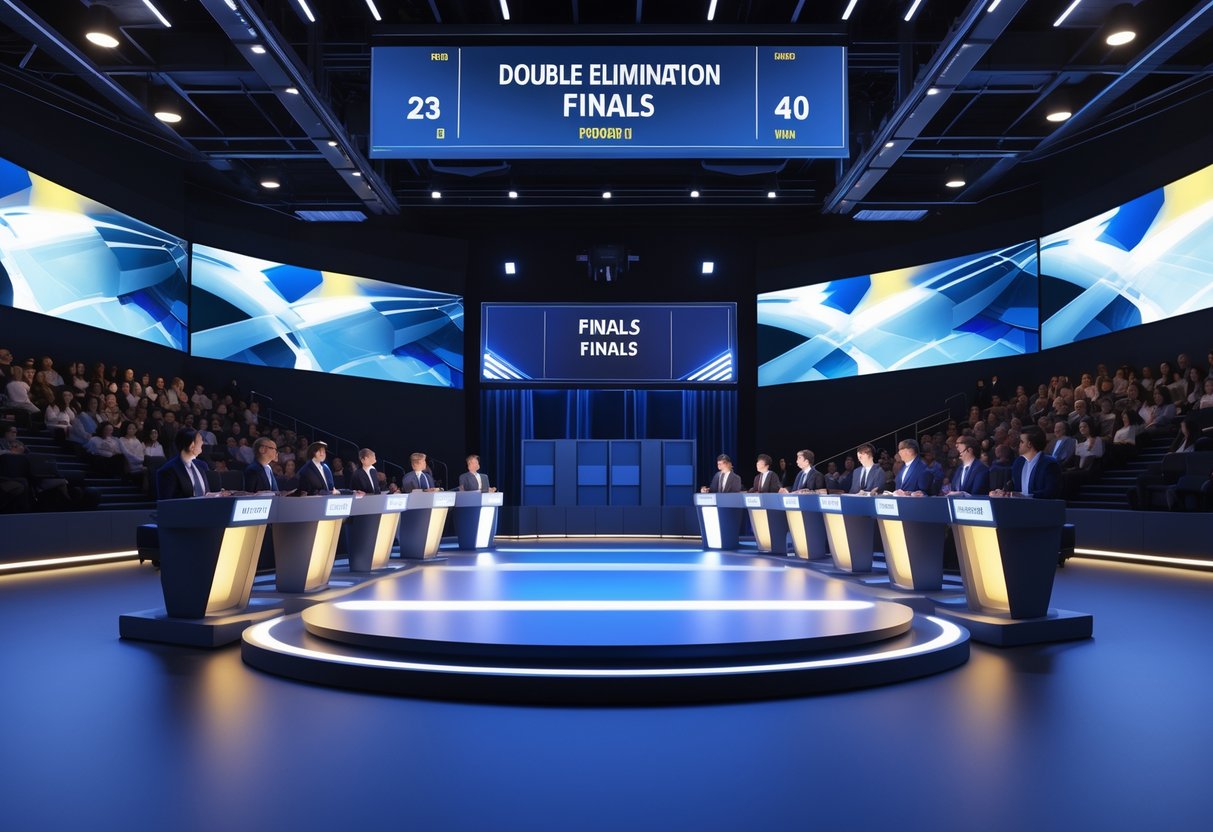
Finals in double elimination don’t look quite like what you see in single elimination tournaments.
The championship round needs special rules to keep things fair, and the “if-game” system makes sure both finalists really have to lose twice to be knocked out.
Championship Game Format
Two finalists make it through: one from the winners’ bracket, still undefeated, and one from the losers’ bracket, who already took a loss but fought back.
That creates a bit of a lopsided situation.
The winners’ bracket finalist only needs one win to take it all, while the losers’ bracket finalist has to win two in a row.
Here’s how it usually works:
- Winners’ bracket finalist needs one victory for the title
- Losers’ bracket finalist must win twice to become champ
- Both matches usually run back-to-back
Most esports tournaments, like Counter-Strike and League of Legends events, use this setup.
Fighting games like Street Fighter do the same.
It can make scheduling a bit tricky for broadcasters, since you never know if that second match will actually happen until the first one wraps up.
If-Game and Bracket Reset Explained
The “if-game,” sometimes called a “bracket reset,” happens when the losers’ bracket finalist beats the winners’ bracket finalist in the first championship match. That win triggers a second, winner-takes-all showdown between the same two players or teams.
Here’s how bracket reset plays out:
First Championship Game:
- If the winners’ bracket finalist wins, the tournament ends right there.
- If the losers’ bracket finalist wins, the bracket resets.
Second Championship Game (if needed):
- Both competitors now have one loss.
- Whoever wins this match takes the championship.
- It’s single elimination at this point.
This setup makes double elimination actually mean something. Without the reset, the winners’ bracket finalist would only get one shot to lose, which isn’t really fair. The whole point is that everyone should have to lose twice before they’re out.
Some modern esports events skip the bracket reset to save time. For example, Dota 2’s The International sometimes just goes with a single grand final. Purists aren’t thrilled about that, arguing it doesn’t stick to true double elimination.
The bracket reset keeps things fair and upholds the integrity of the championship round.
Advantages of Double Elimination

Double elimination tournaments give teams a second chance after their first loss. This format creates balanced competition across different skill levels. That’s probably why it’s become so popular in both esports and traditional sports.
Second Chances and Fairness
The biggest draw of double elimination is the safety net it offers. Teams can lose once and still claw their way back to the top through the losers’ bracket.
This structure helps protect against those off days or unlucky moments. Even the best teams sometimes run into technical issues, illness, or just plain bad luck.
Key fairness benefits:
- Teams must lose twice before they’re eliminated.
- One upset doesn’t end a team’s run.
- The format better reflects true skill levels.
- Controversial referee calls have less impact.
Gaming expert James Connolly once said, “double elimination gives us a much clearer picture of which team truly deserves to win, rather than who simply avoided an early upset.” It’s hard to disagree.
The format also softens the blow of tough seeding. If two top teams meet early, the loser still has a path to the finals.
Balanced Competition for All Teams
Double elimination keeps the competition engaging from start to finish. Teams in the losers’ bracket often play with extra fire, knowing they’re on their last chance.
The format mixes up matchups. As teams bounce between brackets, they run into opponents with different playstyles and strategies.
Competition benefits:
| Winners’ Bracket | Losers’ Bracket |
|---|---|
| Keeps momentum | High-pressure environment |
| Fewer matches | More matches required |
| Advantage in finals | Must prove resilience |
Double elimination tournaments usually have 80-90% more matches than single elimination ones. More games mean a better shot at finding the strongest team.
Teams sometimes reinvent themselves mid-tournament when their backs are against the wall. It’s not rare to see early losers adapt, find their groove, and storm back through the bracket.
Both finalists have to prove something under pressure. One might stay undefeated, while the other fights back from a loss—either way, they’ve earned their spot.
Double Elimination vs Single Elimination Debate
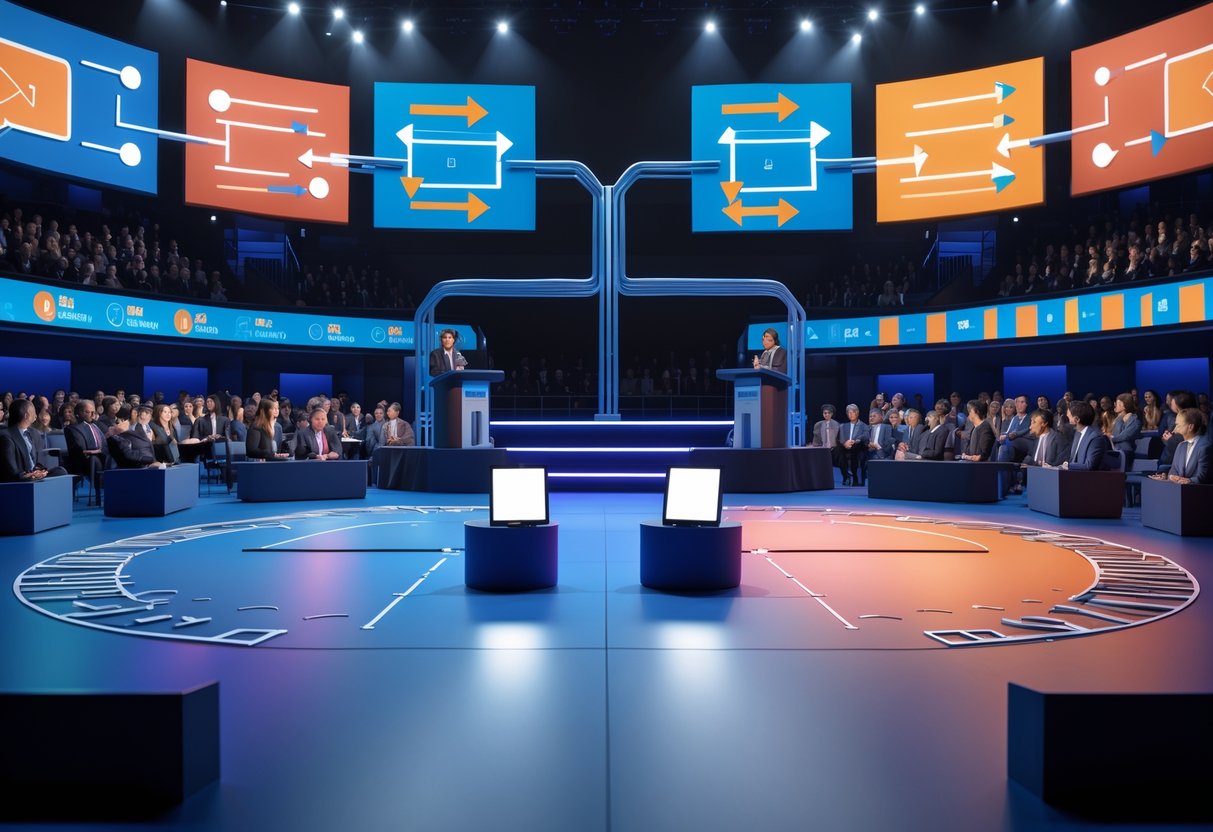
People love to argue about tournament formats. The main question: do players deserve second chances, or is instant elimination more exciting? Single elimination brings drama, but it can knock out top teams early. Double elimination offers fairer results but takes more time.
Competitive Dynamics
Single elimination forces teams to play at their best from the first round. There’s no room for warming up—one bad match and you’re out.
This can backfire when strong teams face each other early. A top-seeded team might get knocked out before really showing what they can do.
Double elimination fixes this. Teams get a second shot in the losers’ bracket, so an early stumble doesn’t have to end their run.
Most pros actually prefer double elimination. It rewards consistency, not just one hot streak or lucky break. Technical issues or bad luck won’t instantly end your tournament.
Still, the format can confuse newcomers. Winners’ and losers’ brackets, grand finals advantages—it can be a lot to explain compared to the simplicity of single elimination.
Double elimination gives a more accurate skill assessment. Teams face more opponents and have time to adapt, so the best teams usually rise to the top.
Spectator Engagement
Single elimination brings pure adrenaline. Every match is do-or-die, and fans get hooked on the tension. When underdogs pull off upsets, those moments become legendary.
It’s also easier to follow. Schedules are clear, and viewers know exactly when things will wrap up.
Double elimination tells a different story. Fans love watching teams mount comebacks through the losers’ bracket. There’s something special about a redemption arc.
But longer tournaments can wear out viewers. Not every match feels high-stakes when teams get second chances.
Double elimination usually means bigger prize pools. More matches mean more sponsorship and ticket sales, which can bump up the prize money.
Broadcasting gets trickier. Producers have to explain the dual brackets and manage longer schedules, but the upside is more content to share and monetize.
Scheduling and Logistical Considerations

Double-elimination tournaments need almost twice as many matches as single elimination. That creates serious scheduling headaches. Organizers have to juggle match frequency and participant fatigue to keep things fair.
Number of Matches and Rounds
Double elimination dramatically increases the total number of matches. For example, a 64-team single elimination tournament needs 63 games. Double elimination with the same teams? That jumps to about 125-126 matches.
This happens because the format splits into two brackets. The winners’ bracket works like a normal single elimination. The losers’ bracket catches every team that loses once and gives them another shot.
Match counts for typical tournaments:
- 32 teams: 61 matches (vs 31 in single elimination)
- 64 teams: 125 matches (vs 63 in single elimination)
- 128 teams: 253 matches (vs 127 in single elimination)
The grand final can get messy. If the losers’ bracket champ beats the winners’ bracket champ, they play again. That “bracket reset” can stretch the finals by hours.
Organizers often run matches in parallel to handle the extra load. That means more venues, more gear, and more staff.
Managing Time and Fatigue
Long tournaments wear people out. Teams that go deep in both brackets might play 8-10 matches over several days. It’s a real test of endurance.
Common scheduling tricks:
- Spreading the event over 2-3 days instead of cramming everything into one.
- Giving teams mandatory 30-60 minute breaks between matches.
- Starting the losers’ bracket while the winners’ bracket is still going.
Late in the tournament, you can see match quality drop. Mental fatigue creeps in, mistakes happen, and strategies get sloppy. Some tournaments cap daily matches at 3-4 per team.
Time management is crucial, especially if venues have strict hours or broadcasts are on a tight schedule. Organizers need buffer time for tech delays, overtime, and possible bracket resets.
The commitment can scare off casual players. Double elimination events often take up entire weekends, while single elimination can wrap up in a day.
Applications in Sports and Esports
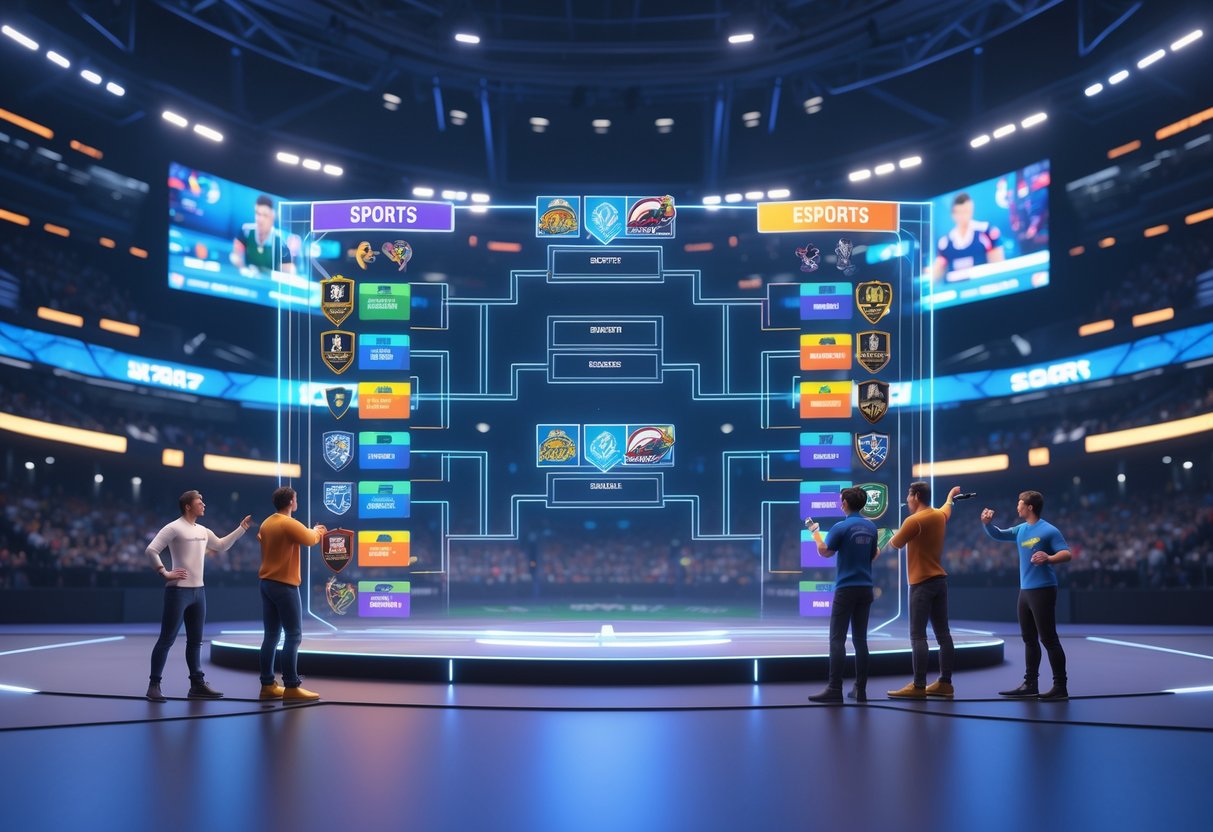
Double elimination isn’t just for video games. You see it in traditional sports and competitive gaming alike. The format gives everyone a second chance and more matches for fans.
Traditional Sports Tournaments
Lots of sports use double elimination to keep things fair. Tennis often uses it in qualifying rounds.
Boxing and martial arts tournaments like the format too. Fighters get more than one shot, and fans get more interesting matchups.
Baseball leagues such as the Little League World Series use a modified double elimination. Teams that lose early aren’t done—they get another chance, which keeps more teams involved longer.
Some Olympic events use double elimination, especially in combat sports and team competitions. After years of training, athletes deserve a bit more than a single elimination.
Key benefits:
- Fairer results
- More matches for TV
- Early upsets matter less
- Fans stay engaged
Esports Events and League of Legends
Double elimination really shines in esports. League of Legends tournaments use it to create comeback stories that fans talk about for ages.
Big events like The International use double elimination with great success. Teams can lose early, regroup, and still win it all. That makes for amazing storylines and keeps viewers invested.
Dota 2’s top tournament shows how the format works for esports. Lower bracket runs become legendary moments.
League of Legends World Championship fans keep asking for double elimination. They argue it would make the results more fair. Right now, single elimination can send strong teams home too soon.
Esports advantages:
- More content for streams
- Less randomness in crowning champions
- More viewers thanks to longer events
- Better stories for content creators
Community Perspectives and Ongoing Debate

Double elimination sparks plenty of debate in competitive gaming circles. Some swear it’s the fairest format, while others push for simpler, faster tournaments.
Opinions on Format Fairness
Supporters say double elimination gives teams a real shot at success. One bad match shouldn’t erase months of hard work.
A lot of semi-pro players like having that second chance. It lowers the stress of single-game eliminations, which can feel a bit random.
Organizers often back double elimination for different reasons:
- More viewers thanks to longer tournaments
- More chances for sponsors to get seen
- Extra revenue from extended broadcasts
Critics have their points too. The grand finals can feel unfair—sometimes one team needs two wins, while the other only needs one.
Some coaches worry about player burnout. Double elimination tournaments can drag on, testing stamina as much as skill.
Casual viewers sometimes get lost in the format. Bracket resets and losers’ bracket progress can be confusing if you’re new to esports.
Demand for Format Changes
Tournament reforms are picking up steam. Organizers keep experimenting with hybrid formats that mix single and double elimination.
Some regional tournaments are moving to shorter formats. Swiss system prelims followed by single elimination playoffs help cut down the time.
Player surveys show mixed opinions. Veterans lean toward double elimination, while newer players seem to prefer simpler brackets.
Broadcast schedules matter a lot. Streaming platforms want events that finish on time and don’t mess with prime viewing hours.
A few big tournaments have switched to single elimination for their finals. That makes for big moments, but it also means one bad day can end a team’s run.
Some scenes are finding middle ground. Modified double elimination drops the bracket reset and gives both finalists one shot in a single, winner-takes-all match.
Notable Examples of Double Elimination
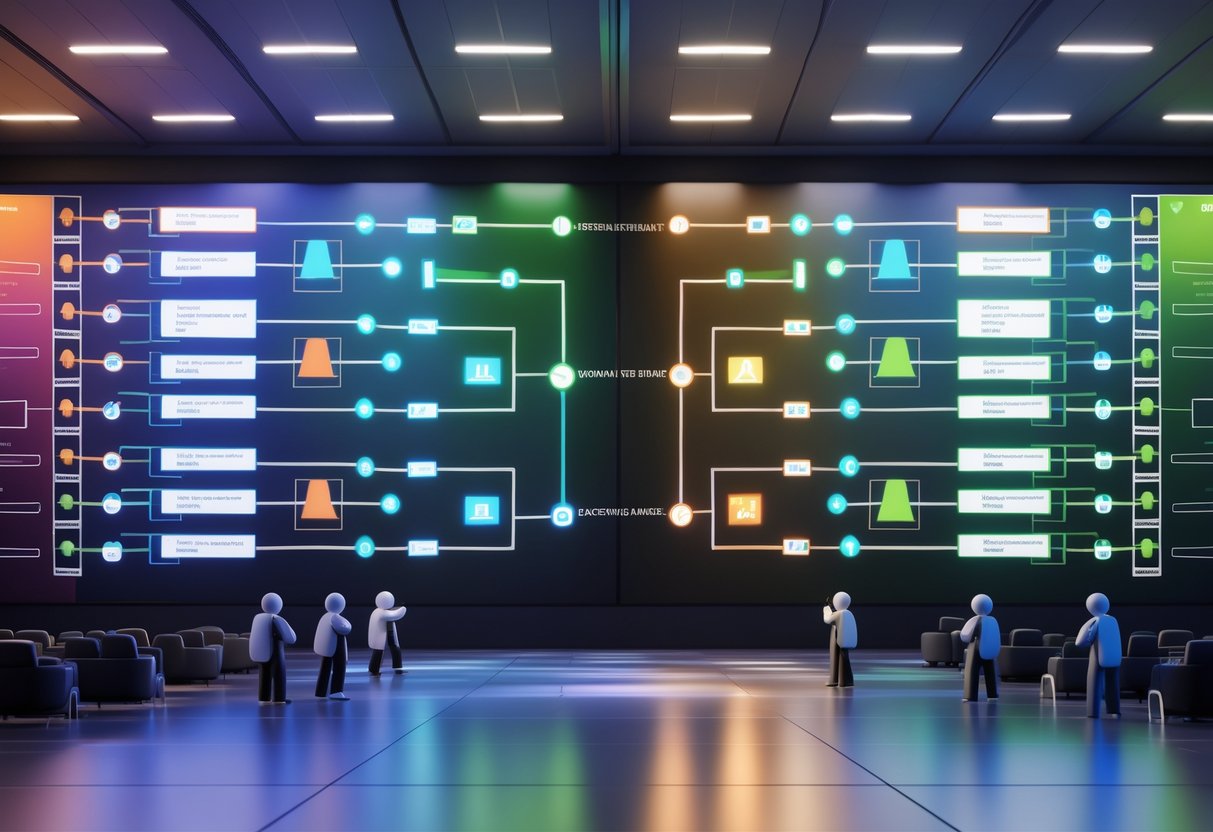
Double elimination tournaments have shaped some of the most exciting competitions in traditional sports and esports. Major events like the Little League World Series show off the format’s fairness, while games like League of Legends really bring out its dramatic side.
Memorable Tournaments and Matches
The Little League World Series stands out as one of the most recognized examples in traditional sports. Young players get a second shot after losing their first match, and that often leads to some wild comeback stories.
This format gives teams a chance to fight through the loser’s bracket and reach the championship. Sometimes, the underdog story totally takes over the narrative.
League of Legends tournaments use double elimination a lot during their regional playoffs. Teams like TSM and Cloud9 have clawed their way through the loser’s bracket to qualify for international events.
The format lets fans witness “bracket resets” in the grand finals. If the loser’s bracket champion beats the winner’s bracket champion, the two teams face off again to settle the score.
NCAA Beach Volleyball uses double elimination in many championship events. The format fits smaller team pools where every match feels huge.
Evolution Across Competitions
Double elimination has changed a lot across different competitive scenes. Traditional sports usually stick with it for youth events and smaller tournaments where fairness seems more important than TV schedules.
Esports organizers seem to love the format. Games like League of Legends regional leagues rely on it to pick which teams advance to international championships.
Tournament organizers have tweaked the format to fit streaming and broadcast needs. They now schedule loser’s bracket matches to keep viewers engaged throughout long events.
Modern tournaments often mix things up. Some use Swiss group stages first, then switch to double elimination playoffs—honestly, it’s a pretty smart blend.
Some competitions have dropped pure double elimination because of time crunches. Still, hybrid formats that keep that “second chance” vibe remain really popular in both sports and gaming.
Frequently Asked Questions
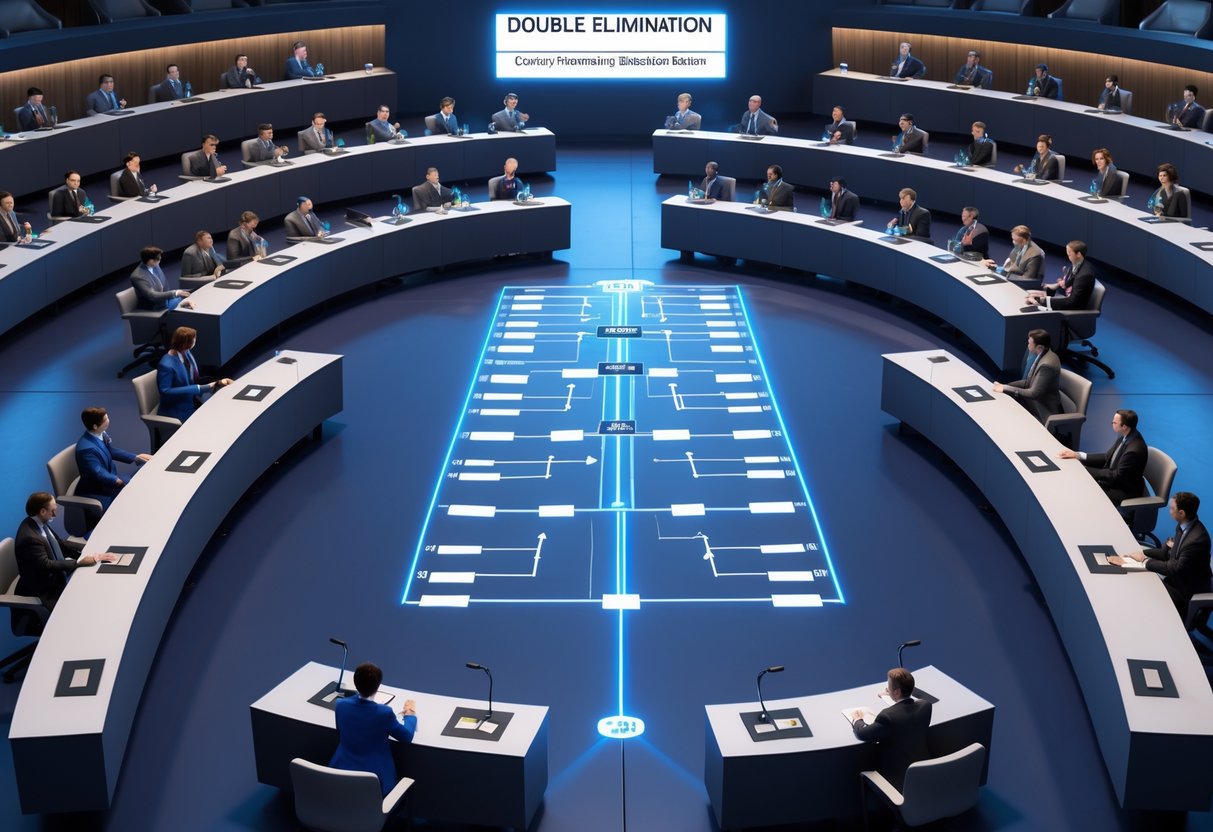
Double elimination debate tournaments can look confusing at first. Once you get the basics, though, teams can navigate these events with a lot more confidence.
Teams get another opportunity after their first loss, which creates some strategic options that you just don’t see in single elimination.
How does a double elimination format work in debate competitions?
In double elimination debate tournaments, teams play in two brackets: the winners and the losers bracket. If a team loses its first debate, it drops into the losers bracket instead of heading home.
Teams have to lose twice before they’re out for good. So, a team can stumble once and still make it all the way to the championship.
The winners bracket keeps moving with teams that haven’t lost yet. Meanwhile, the losers bracket gets tougher as more teams drop down.
What’s the difference between single and double elimination in tournaments?
Single elimination tournaments send teams home after just one loss. No second chances—every debate feels like a final.
Double elimination gives teams a bit of a cushion. It usually leads to more balanced competition since strong teams can recover from an early upset or a tough draw.
The structure gets a little more complicated in double elimination. Teams face different opponents and have to adjust their strategies depending on the bracket.
Can teams re-enter the competition after losing in a double elimination debate?
Teams can’t re-enter once they’ve lost twice. Still, losing once doesn’t mean their tournament is over.
After that first loss, teams drop into the losers bracket and keep competing. They have to win every debate from then on to stay alive.
One more loss and they’re out. The losers bracket gets pretty intense since every debate could be the last.
What strategies should teams adopt for success in double elimination debates?
I’d say teams should prep differently for each bracket. In the winners bracket, you might test new arguments or strategies because you’ve got that safety net.
In the losers bracket, though, you need your best stuff. There’s no room for error—bring your strongest cases and your sharpest delivery.
Pacing matters a lot in double elimination. Teams in the losers bracket often end up debating more, so managing energy and focus is key.
How is the winner decided in a double elimination debate tournament?
The finalist from the winners bracket faces the finalist from the losers bracket in the grand final. If the losers bracket team wins, both teams have one loss.
Most tournaments then run a second grand final debate. That way, the champ is either undefeated or has beaten the other finalist twice.
Some tournaments set their own rules for the grand final. Always check the tournament guidelines ahead of time so you know what to expect.
What are the benefits of using a double elimination system in debate events?
Double elimination gives everyone a fairer shot by cutting down on the bad luck of early tough matchups. When strong teams run into tough opponents right away, they still get another chance to show what they’ve got.
This format brings out more exciting stories as teams fight their way back through the losers bracket. Sometimes, we even get those wild comebacks that just can’t happen in a single elimination setup.
Debaters also get to participate in more rounds, which means better value and more chances to learn. Newer teams especially appreciate this since they’re not immediately knocked out after one loss.

